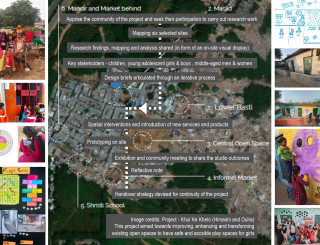Article
Displacement and placemaking in design studios
- Hemmersam, Peter|Chopra, Divya | Dar, Anandini | Breivik-Khan, Håvard | Selmer-Olsen, Tone | Ip, Morgan | Lappi, Tiina-Riitta | Lintelo, Dolf te | Mull, Robert | Adjoubei, Xenia

This article explores how placemaking took place in architectural and design studios working with migrant and displaced communities at universities in three countries. Placemaking is a dimension of architectural and urban design practice that is emulated in architectural design studios – and often takes the form of a top-down and expert-driven exercise. In contrast, bottom-up placemaking is constituted through spontaneous and everyday practices in a given locality. The studios engaged with social scientists with a particular focus on displaced and immigrant communities. In Delhi, a multi-disciplinary social design studio at Ambedkar University applied community engagement and a service design approach to sustainable social interventions with a physical design component. At the University of Brighton, UK, an architectural design/build studio aimed at actual construction and transgressed the studio boundary to work closely with a charity supporting young refugees. In Norway, architecture students in an urbanism studio at the Oslo School of Architecture and Design surveyed an immigrant-dominated modernist housing district and proposed architectural and urban space interventions. Across the studios, student projects ranged from visualising futures to physical and social interventions. Learning outcomes varied, including design and planning skills, community engagement methods, co-design approaches and training in reflexivity. Venturing beyond the studio entailed engaging in sociocultural learning practices, engaging urban complexities and challenging expert authority and epistemologies in architecture and design education.

